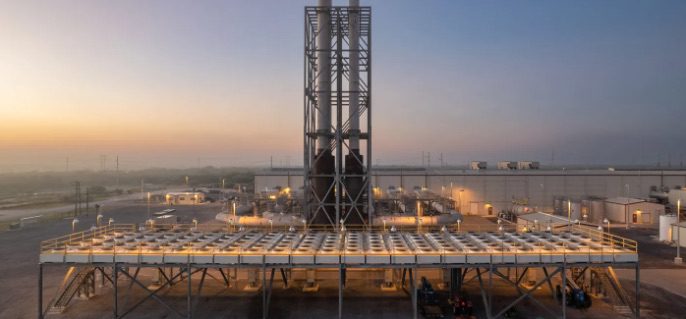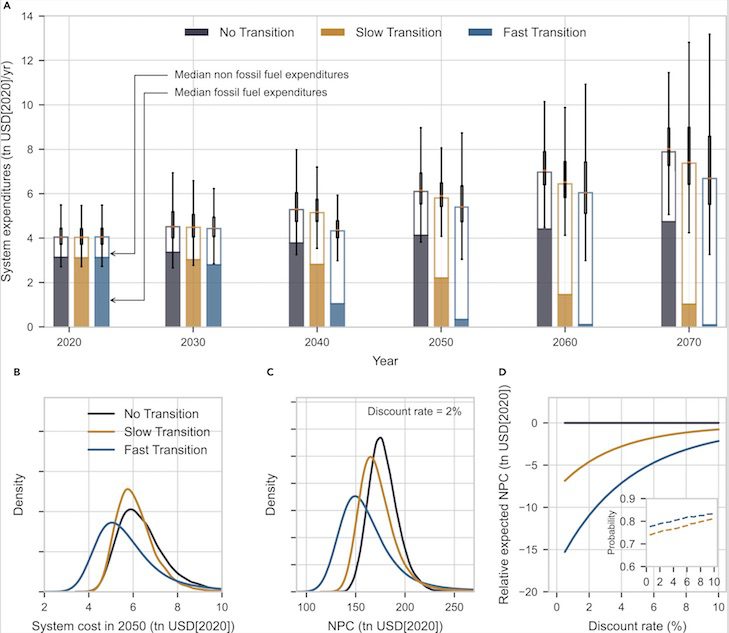28 November 2024
Accelerating the green energy transition before 2030

We are witnessing our planet warming at a record pace, likely breaching the 1.5°C climate target by the first half of the 2030s. But there is no reason to lose hope. By accelerating the green energy transition, we can still turn things around.
Table of Contents
Concept
The planet is heating up beyond tolerable limits and there seems to be no end in sight. The IPCC expects we will cross the 1.5°C global warming mark by the first half of the 2030s.
“We are already at around 1.1°C, and our emissions have yet to peak. We must turn around our global economies and race to net zero emissions over the coming decade. Fortunately, the technological progress in renewables and batteries suggests that such a fast transition is achievable with the right policies,”
Matthew Ives, Complex Systems Economic Modeller, University of Oxford’s Institute for New Economic Thinking
While batteries support a faster energy transition, we still need to consider their environmental impact because they are material-intensive and can cause hazardous waste, greenhouse gas emissions, and toxic gases during disposal and recycling. Even so, they remain an integral part of scaling up renewables.
The economic case for a faster energy transition
Ives suggests that the safest and cheapest option is to continue investments in clean energy technologies that have consistent cost declines, such as solar, wind, batteries, and electrolyzers for hydrogen.
“We modeled a fast energy transition to a renewable plus storage-based global energy system and found that the world could save trillions from this energy transition and electricity could cost half as much as it does currently – just imagine the economic benefits this would bring.”
Matthew Ives, Complex Systems Economic Modeller, University of Oxford’s Institute for New Economic Thinking
Nette Lehtinen, argues that the first step to meet our climate targets is to get rid of coal in energy generation. Citing the example of solar photovoltaic module prices, she demonstrates the potential and need for cost reduction at scale.
“Rapidly adopting green technologies leads to economies of scale, driving down manufacturing and deployment costs. And faster adoption sends a clear signal to investors, fostering confidence and attracting capital, which can further accelerate technology development and cost reduction.”
“While there might be upfront investments in energy transitioning to green technologies, the long-term cost savings due to lower operational and maintenance costs outweigh the initial expenditures,”
Nette Lehtinen, Director of strategy and business intelligence, Wärtsilä Energy
Debunking the expensive renewables myth
A peer-reviewed paper on empirically grounded technology forecasts and the energy transition by Ives and his associate Rupert Way points out that the fear of high costs has influenced decisions about the decarbonization of global energy systems. However, it also reveals that most energy economy models overestimate future costs by underestimating improvements in renewable energy cost and their deployment rates.
Rupert Way, co-author of the report and researcher at the Institute for New Economic Thinking, Oxford Martin School, says we need to update our expectations of the cost of the clean energy transition.
“People have been assuming that renewable energy technologies would remain more expensive than fossil fuels for decades into the future, but this view is wildly outdated. Following many years of consistent innovation and technological progress, solar, wind, batteries, and electric vehicles (EVs) are now cheaper than fossil fuel alternatives in many places around the world. So, we need to get the message out that these are not only the cleanest options, but also the cheapest options, and that they will be a lot cheaper in future than most people have been expecting.”
Rupert Way, Researcher, Institute for New Economic Thinking, Oxford Martin School
Way points out that the biggest hurdles in switching to clean energy are no longer costs, but permitting-related issues, grid infrastructure modernization, and a skills gap.
“We need to focus our effort on electrifying as much of the economy as possible, gaining experience with these new technologies, and getting it all connected and operating smoothly. Technologies related to computing and electricity improve very quickly, much faster than those involving fluids and combustion, so to reduce overall energy transition costs we should prioritize digitization and electrification, and accelerate the build-out of new RE (Renewable Energy) generation to displace fossil fuels. We also need to ramp up the workforce to handle these new technologies, which are crucial for the energy transition.”
Rupert Way, Researcher, Institute for New Economic Thinking, Oxford Martin School
A symbiotic power generation approach
Along with a better and connected network of transmission grids, there is a need to build a portfolio of different energy generation and storage technologies that support each other.
“I believe a major part of the solution to climate change is technological progress. I know this sounds like ‘technofix’, but it is mostly a technology problem – that being the emissions from fossil fuel technologies,”
“New clean technologies have their own problems, like the intermittency of renewables, but we are rapidly learning how to manage these with storage and greater transmission infrastructure and smarter grids, to the point that we are actually making our energy systems more reliable and secure.”
Matthew Ives, Complex Systems Economic Modeller, University of Oxford’s Institute for New Economic Thinking
For instance, technologies such as Power-to-X-to-Power enhance the economic attractiveness of RE investments by utilizing high RE power generation, low demand, and price movements to generate green hydrogen and derivatives, which can later be utilized in periods of high demand and prices.

Power-to-X fuels (P2X) new potential for power generation
Wärtsilä has published a new whitepaper, examining on the potential of Power-to-X fuels (P2X) for power generation.
Ship Nerd
Similarly, battery energy storage helps increase the stability and reliability of the system by storing excess energy during periods of high generation and releasing it during low generation. It also helps reduce the need for rapid ramping of conventional power sources to balance fluctuations.
But renewables could be cannibalistic in certain situations, explains Lehtinen. For instance, in windy conditions, wind generation increases, and prices go down, leading to a decline in revenues and economic incentives to invest.
“It is important to integrate a good mix of technologies for a reliable and forward-moving energy system. Technologies like balancing engines and reciprocating internal combustion engines (RICE) offer rapid ramp-up and ramp-down capabilities, providing flexible backup to match changing demand patterns.”
Nette Lehtinen, Director of strategy and business intelligence, Wärtsilä Energy
Reciprocating engines can provide energy at full load in less than 5 minutes and run for longer hours than batteries. They can run on natural gas, diesel, or both and are capable of burning hydrogen, ammonia, or methanol to support a carbon-free combustion cycle.
The time to adapt is now
A good energy portfolio of technologies such as these helps increase the efficiency of the energy system at large. For instance, integrating renewables with Energy Management Systems can enable real-time monitoring, control, and optimization of energy resources to maximize renewable energy utilization and minimize reliance on conventional sources.
“There are many new demand management and power grid control technologies that are either already available or under development now. These are essential in high renewables systems because they allow us to coordinate the consumption of electricity with supply. These technologies rely heavily on electronics and computing, and are very cost-effective,”
Rupert Way, Researcher, Institute for New Economic Thinking, Oxford Martin School
It is critical to highlight the indispensable role of digitalization and Smart Energy Networks in the global energy transition to clean energy. Internet of Things (IoT) devices enable operators to manage complex energy systems more efficiently. Advanced computing technologies such as smart sensors, predictive analytics, and data-driven insights allow them to anticipate changes, optimize energy dispatch, and ensure seamless integration of diverse technologies over a period of time.
“Investments in energy generation are long-term, and it makes sense not to invest in technologies or projects that could lead to stranded assets. Wärtsilä takes future readiness seriously in our R&D, ensuring that our engines can be converted to green fuels when those are available and economically competitive,”
Nette Lehtinen, Director of strategy and business intelligence, Wärtsilä Energy

(A) Colored bars show median annual expenditures on fossil fuel and non-fossil fuel technologies in each scenario in trillions of dollars (tn USD). Boxplots show the median and interquartile range (IQR) of total annual expenditures, and whiskers extend from the box by 1.5 times the IQR.
(B) Forecast distributions of the annual system cost in 2050 for each scenario.
(C) Forecast distributions of the net present cost (NPC) of each scenario, for a fixed discount rate of 2%.
(D) Expected net present cost of each scenario relative to the No Energy Transition scenario, as a function of the discount rate. The inset shows the probability that the NPCs of the Fast Energy Transition and Slow Energy Transition will be lower than that of the No Energy Transition, as a function of the discount rate.
Source: Wärtsilä
See Also
Leading climate scientist James Hansen says ‘global warming will accelerate’. The past five months have shattered global temperature records, taking scientists by surprise. Many are asking why.

Scientists warn global warming will accelerate – due to reduction in ship pollution
A new study published in Oxford Open Climate Change, suggests global warming will accelerate due to reduction in ship pollution


